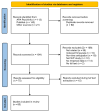The Role of the Serotonergic System in Time Perception: A Systematic Review
- PMID: 39769070
- PMCID: PMC11679555
- DOI: 10.3390/ijms252413305
The Role of the Serotonergic System in Time Perception: A Systematic Review
Abstract
Time perception is a fundamental cognitive function essential for adaptive behavior and shared across species. The neural mechanisms underlying time perception, particularly its neuromodulation, remain debated. In this review, we examined the role of the serotonergic system in time perception (at the scale of seconds and minutes), building a translational bridge between human and non-human animal studies. The literature search was conducted according to the PRISMA statement in PubMed, APA PsycINFO, and APA PsycARTICLES. Sixty papers were selected for full-text review, encompassing both human (n = 10) and animal studies (n = 50). Summarizing the reviewed literature, we revealed consistent evidence for the role of serotonin in timing behavior, highlighting its complex involvement across retrospective, immediate, and prospective timing paradigms. Increased serotonergic activation appears to accelerate internal time speed, which we interpret through the dual klepsydra model as accelerated discharge of the temporal accumulator. However, some findings challenge this framework. Additionally, we link impulsivity-associated with decreased serotonergic functioning in our review-to a slower internal time speed. Variability in prospective timing tasks underscores the need for further research into how serotonin modulates reward-based temporal decisions, using novel approaches to disentangle internal time speed, response inhibition, and other factors.
Keywords: 5-HT; impulsivity; interval timing; serotonergic regulation; serotonin; time perception; timing schedules.
Conflict of interest statement
The authors declare no conflicts of interest. The funders had no role in the design of the study; in the collection, analyses, or interpretation of data; in the writing of the manuscript; or in the decision to publish the results.
Figures
Similar articles
-
Regional cerebral blood flow single photon emission computed tomography for detection of Frontotemporal dementia in people with suspected dementia.Cochrane Database Syst Rev. 2015 Jun 23;2015(6):CD010896. doi: 10.1002/14651858.CD010896.pub2. Cochrane Database Syst Rev. 2015. PMID: 26102272 Free PMC article.
-
Interventions for promoting habitual exercise in people living with and beyond cancer.Cochrane Database Syst Rev. 2018 Sep 19;9(9):CD010192. doi: 10.1002/14651858.CD010192.pub3. Cochrane Database Syst Rev. 2018. PMID: 30229557 Free PMC article.
-
Short-Term Memory Impairment.2024 Jun 8. In: StatPearls [Internet]. Treasure Island (FL): StatPearls Publishing; 2025 Jan–. 2024 Jun 8. In: StatPearls [Internet]. Treasure Island (FL): StatPearls Publishing; 2025 Jan–. PMID: 31424720 Free Books & Documents.
-
Gender differences in the context of interventions for improving health literacy in migrants: a qualitative evidence synthesis.Cochrane Database Syst Rev. 2024 Dec 12;12(12):CD013302. doi: 10.1002/14651858.CD013302.pub2. Cochrane Database Syst Rev. 2024. PMID: 39665382
-
Home treatment for mental health problems: a systematic review.Health Technol Assess. 2001;5(15):1-139. doi: 10.3310/hta5150. Health Technol Assess. 2001. PMID: 11532236
Cited by
-
Time Perception Test in IntelliCage System for Preclinical Study: Linking Depression and Serotonergic Modulation.Diagnostics (Basel). 2025 Jan 10;15(2):151. doi: 10.3390/diagnostics15020151. Diagnostics (Basel). 2025. PMID: 39857035 Free PMC article.
References
-
- Parker J.A., Harris P.A., Steineck C. Time: Limits and Constraints. BRILL; Leiden, The Netherlands: 2010.
-
- Kant I. Modern Classical Philosophers. Houghton Mifflin; Cambridge, MA, USA: 1908. Critique of Pure Reason. 1781; pp. 370–456.
-
- Pöppel E. Time Perception. In: Held R., Leibowitz H.W., Teuber H.L., editors. Perception. Handbook of Sensory Physiology. Volume 8 Springer; Berlin/Heidelberg, Germany: 1978.
Publication types
MeSH terms
Substances
Grants and funding
LinkOut - more resources
Full Text Sources


